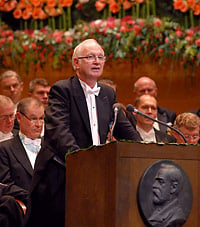Award ceremony speech
Presentation Speech by Professor Professor Börje Johansson, Member of the Royal Swedish Academy of Sciences, Member of the Nobel Committee in Physics, 10 December 2007.
 |
| Professor Börje Johansson delivering the Presentation Speech for the 2007 Nobel Prize in Physics at the Stockholm Concert Hall. Copyright © The Nobel Foundation 2007 Photo: Hans Mehlin |
Your Majesties, Your Royal Highnesses, Ladies and Gentlemen,
This year’s Nobel Prize in Physics concerns magnetism and electricity, more specifically how an external magnetic field can influence the electrical resistance of a metal.
According to Alfred Nobel’s will, the Nobel Prize in Physics is to be awarded for the discovery or invention that has conferred the greatest benefit on mankind. In their discovery of Giant Magnetoresistance Albert Fert and Peter Grünberg have provided us with an invention whose importance cannot be doubted. One can in all justice say that this effect is one prerequisite for the modern IT revolution.
Uses of electricity are among the applications of physics that have most clearly served mankind throughout modern history. When, in the early 19th century, the British physicist Faraday made his first hesitant experiments involving electricity during his public demonstrations, one of those watching was Gladstone, at that time Chancellor of the Exchequer. When he asked if the experiment could lead to any practical benefits Faraday’s immediate answer was “One day you will be able to tax it”. Few findings can have pleased as many ministers of finance through the ages as those related to the movements of electrons.
In traditional electronic applications, it is the charge of the electrons that is exploited. But electrons have another feature, namely their own rotation or spin. This spin brings with it an element of magnetism. The electron is like a tiny magnet that either points upwards or downwards. In what we call ferro-magnetic metals, such as iron, there are considerably more electrons with magnetism upwards than downwards. The overall effect is what gives iron its magnetic qualities.
When an electric current is transmitted through a metal or another conductor – irrespective of whether it is magnetic or not – the movement of the electrons is impeded by atomic irregularities in the material. It is these obstructions at atomic level that result in what we call the electrical resistance. In a ferro-magnetic metal like iron, however, we encounter something specific. The resistance for spin-up electrons differs from the resistance for spin-down electrons. This means that the resistance of the material can be influenced magnetically.
The discovery, or invention, of Giant Magnetoresistance is an unusually clear example of the interaction of technological developments and fundamental scientific insights. One prerequisite for the discovery of this new phenomenon was the technology that developed in the 1980s in the wake of the emerging semi-conductor industry: nascent nanotechnology.
Peter Grünberg and Albert Fert both used the art of creating nanometre thin layers of only a few atoms’ thickness in order to learn more about how magnetic materials behave. They discovered simultaneously, but independently of each other, that an external magnetic field could have a very great impact on electrical resistance if the magnetic layers alternated with non-magnetic layers. The concept of Giant Magnetoresistance was coined to refer to this new phenomenon.
Retrieving data from hard disks is one of the most important applications of Giant Magnetoresistance, since the information is stored on the hard disks in the form of small magnetic areas. Giant Magnetoresistance can be used by the read-out head that scans the hard disk and converts the magnetic information into electrical current.
But this is merely one of a horde of potential application areas. Giant Magnetoresistance also means the beginning of an entirely new form of electronics, spintronics, in which both the spin and the charge of electrons can be exploited.
Cher Professeur Fert: votre découverte de la magnétoresistance géante a déjà transformé le monde de l’informatique et les promesses pour le futur sont importantes et nombreuses.
Lieber Herr Professor Grünberg: Ihre Entdeckung des Riesenmagnetowiderstands hat bereits die Welt der Informationstechnologie verwandelt und die Verheißungen für die Zukunft sind groß.
Professor Fert and Professor Grünberg: You have been awarded the 2007 Nobel Prize in Physics for your discovery of Giant Magnetoresistance. It is an honour for me to convey to you the warmest congratulations of the Royal Swedish Academy of Sciences. I now ask you to step forward to receive your Nobel Prizes from the hands of His Majesty the King.
Nobel Prizes and laureates
Six prizes were awarded for achievements that have conferred the greatest benefit to humankind. The 14 laureates' work and discoveries range from quantum tunnelling to promoting democratic rights.
See them all presented here.
